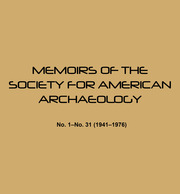No CrossRef data available.
Article contents
Biological Techniques in Archaeology1
Published online by Cambridge University Press: 27 June 2018
Abstract
Analysis of color and cuticular patterns of mammalian hair and examination of epidermal plant cells may be used to identify fragmentary remains from archaeological sites when standard taxonomic procedures cannot be applied. The techniques described will help the non-biologist decide when to request assistance from the specialist. An inexpensive apparatus for taking photomicrographs is described.
- Type
- 4 Techniques
- Information
- Memoirs of the Society for American Archaeology , Volume 19: Contributions of the Wetherill Mesa Archeological Project , October 1965 , pp. 193 - 201
- Copyright
- Copyright © Society for American Archaeology 1965
Footnotes
1
This is Contribution No. 24 of the Wetherill Mesa Archeological Project.
References
Brusven, M. A. and Mulkern, G. B. 1960 The Use of Epidermal Characteristics for the Identification of Plants Recovered in Fragmentary Condition from the Crops of Grasshoppers. North Dakota Agricultural Experiment Station, Research Report, No. 3. Fargo.Google Scholar
Chamberlain, K. 1957 An Introduction to the Science of Photography. Macmillan Company, New York.Google Scholar
Dusi, J. L. 1949 Methods for the Determination of Food Habits by Plant Microtechnique and Histology and Their Application to Cottontail Rabbit Food Habits. Journal of Wildlife Management, Vol. 13, pp. 295–98. Lawrence.Google Scholar
Metcalfe, C. R. and Chalk, L. 1950 Anatomy of the Dicotyledons. 2 vols. Clarendon Press, Oxford.Google Scholar


